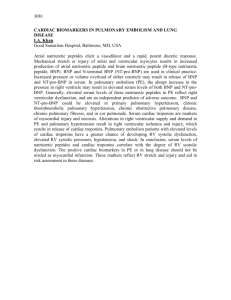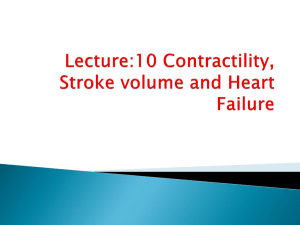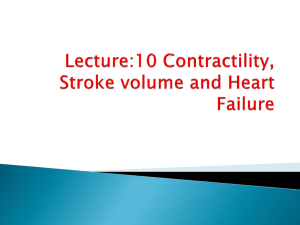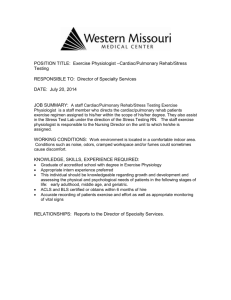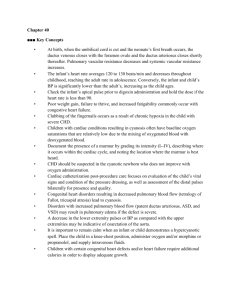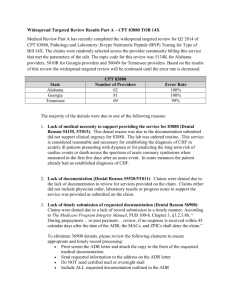CASE
advertisement
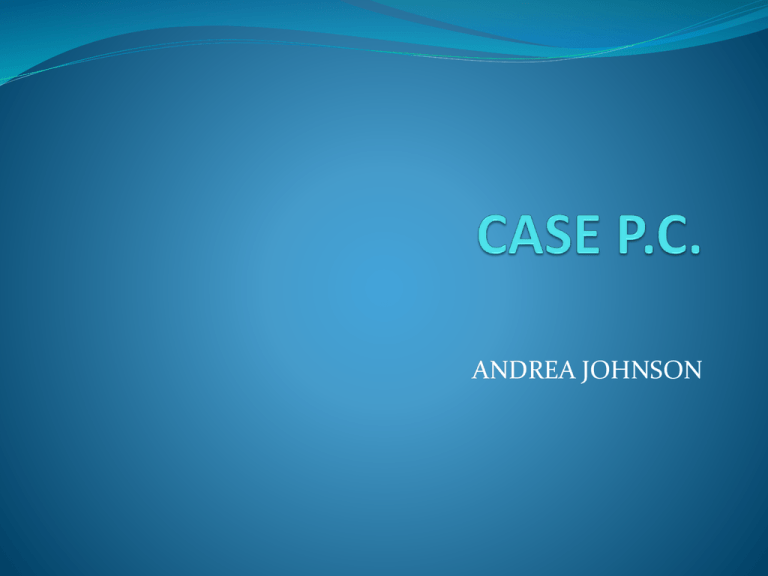
ANDREA JOHNSON P.C. 60 year old female Hypertensive – non-compliant X 1year PRESENTING COMPLAINT SEVERE SOB Began while “swearing & getting on bad” Drank 1 bottle extra strength Codeine Then 20mls rum cream GOT WORSE !!!! DENIED Chest, abdominal or back pain Palpation Nausea or vomiting Diaphoresis Cough fever Previous episodes of SOB History of immobilization PMH NO previous admission to QEH No Diabetes Mellitus/heart disease Admission to Psyche hospital for “social reasons ?!!” - ? # times On no medication Given Natrilix on 1 occasion ~ 1year previously EXAMINATION Obvious CP distress Mm pink, hydration adequate No pedal oedema Temperature 36o C axillary RESPIRATORY SYSTEM OXYGEN SAT (room air)- 78% RR 40/min, use of accessory muscles BS vesicular Creps – laterally + posteriorly Wheeze – throughout posteriorly CARDIOVASCULAR SYS Distal pulses palpable + = bilaterally JVP not elevated PULSE 107/min, regular, synchronous BP 260 / 145 mmHg Normal heart sounds No murmurs ABDOMEN Soft, non-tender No masses or organomegaly Normal BS MUSCULOSKELETAL No calf swelling or tenderness DIASCAN 22.3 MMOL / L ASSESSMENT 1. ACUTE PULMONARY OEDEMA r/o Acute Myocardial Infarction 2. Uncontrolled HTN – 2o non-compliance 3. ? Newly Diagnosed Diabetic PLAN Oxygen 15 L / min- nonbreather face mask GTN 2 puffs – X 2 Nitroglygerin infusion @ 1mcg/kg/min (100mcg/min) Enalapril 1.25mg IV Lasix 60mg IV Aspirin 300mg stat Soluble insulin 10u IV PLAN ECG (RT sided leads subsequently) ABG Cardiac enzymes FBC PT PTT n/a . Urea and electrolytes CXR Urethral catheter + urinalysis RESULTS ECG: sinus, regular LVH with Strain ST depression II, aVF ? ST elevation vs high J point V1-V3 Right sided leads - NAD RESULTS CXR- fluffy opacity throughout ABG – 15 L O2 O2 sat 93.2% pO2 - 74.3 pCO2 – 39.6 HCO3 – 18.1 RESULTS Hb 15.1 WBC 19.8 PLT 332 Sodium 137 Potassium 3.6 Chloride 101 Urea 9.9 Creatinine 125 CK 120 CKMB 41 Troponin I 0.22 FURTHER MX Referred To Med on Call 1 hour after seen significant improvement RR 32/ min, BP 195 / 109, pulse 85/min 2 hours later 1000 mls urine emptied Admitted to MED ON WARD Treated for UTI Day 4 aggressive, speaking loudly Seen by psyche Diagnosis ? Paranoid Schizophrenia vs Delusional disorder ? Hypomanic symptoms DISCHARGE DAY 7 F/U: MOPD + Psyche Hospital TTH: Lasix 40mg od Norvasc Tritace ASA Lipitor Diamicron MR 30mg od Complete Septrin ACUTE CARDIOGENIC PULMONARY OEDEMA ANDREA JOHNSON DEFINITION Leakage of fluid from the pulmonary capillaries and venules into the alveolar space as a result of increased hydrostatic pressure Inability of left ventricle to effectively handle its pulmonary venous return MATTU ET AL PATHOPHYSIOLOGY Angiotensinogen Angiotensin I (LIVER) RENIN ACE Angiotensin II ALDOSTERONE VASOCONSTRICTION PATHOPHYSIOLOGY ↓ CARDIAC OUTPUT INCREASED PCWP SYMTOMATIC DECOMPENSATION ACTIVATION OF RENIN ANGIOTENSIN SYSTEM ACTIVATION OF S/S SYSTEM CARDIAC ISCHAEMIA ↓ LEFT VENTRICULAR FUNCTION INCREASED HEART RATE INCREASED SYSTEMIC VASCULAR RESISTANCE INCREASED PRELOAD PRECIPITATING FACTORS Myocardial ischaemia or infarction Arrhythmias Uncontrolled HTN/HTN crisis Medication Non-compliance Thyrotoxicosis Fluid overload Anaemia Pulmonary & other infections Inappropriate medications- -ve inotropes, NSAIDS CLINICAL FEATURES SOB Orthopnoea - sensitivity 5% - specificity 77% PND Tachycardia BP Wheezing – sensitivity 22% - specificity 58% Crepitations - sensitivity 6% - specificity 78% EMERGENCY MEDICINE PRACTICE DEC 2006 DIFFERENTIAL DIAGNOSIS Physicians only 80% accurate at differentiating Acute Heart Failure from other disease processes DIFFERENTIAL DIAGNOSIS ASTHMA COPD PULMONARY EMBOLISM PNEUMONIA INVESTIGATIONS 1. Blood 2. Electrocardiography 3. Radiologic BLOOD INVESTIGATIONS ABG FBC – anaemia, infection U & Es CARDIAC MARKERS CARDIAC MARKERS CARDIAC ENZYMES OTHER CARDIAC MARKERS OTHER CARDIAC MARKERS B – NATRIURETIC PEPTIDE (BNP) N-TERMINAL PRO BNP PRE-PRO BNP BNP + NT PRO-BNP B – NATRIURETIC PEPTIDE (BNP) EFFECTS 1.Vasodilation 2. Diuresis 3. Natriuresis 4. Suppression of Renin Angiotensin Sys IMPORTANCE OF BNP IN HF 1. Useful in Diagnosis 2. Assessing Severity 3. Predicting short & long-term CVS mortality WHAT LEVELS ? NO HEART FAILURE BNP < 100pg / dl NT PRO-BNP < 300pg / dl HEART FAILURE BNP >500pg / dl NT PRO-BNP > 1000pg / dl 80% Sensitivity for heart failure PROBLEMS !!! GRAY AREA: 100pg/dl – 500pg/dl BNP in non-cardiac conditions Renal disease Age Pulmonary Embolism Cor pulmonale BNP in CCF OBESITY: BMI inversely related to BNP USEFULNESS OF BNP Does not add much when diagnosis certain from clinical presentation Uncertain diagnosis when BNP < 100pg/dl Known baseline in certain conditions 20% obese patients with acute heart failure have values < 100pg/dl ELECTROCARDIOGRAM Ischaemia / infarction Arrhythmia – A fib LVH Prolonged QRS CHEST RADIOGRAPH FINDINGS IN HEART FAILURE Cardiomegaly – 74% sensitive, 78% specific Vascular redistribution Interstitial oedema Pleural effusions (right sided/bilateral) CXR – BUT !! 20% patients with Acute heart failure have none of the “typical features” No longstanding HF- Normal size heart Longstanding CCF – lymphatics COPD – minimal findings Other investigation Echocardiography 1.Identify reversible cause eg tamponade 2.Distinguish between systolic and diastolic dysfunction TREATMENT AIMS ABCs Decrease Preload (right-sided filling) Increase left-sided emptying ↓ Afterload, Cardiac output ± improve LV contractility – inotropes Overall aim- Redistribute fluid out of lungs! AVAILABLE TREATMENT OXYGEN PHARMACOTHERAPY INOTROPIC RX NONINVASIVE POSITIVE PRESSURE VENTILATION PHARMACOTHERAPY AVAILABLE 1. NITRATES 2. DIURETICS 3. ACE INHIBITORS 4. MORPHINE 5. NATRIURETIC PEPTIDES NITRATES NITROGLYCERIN MECHANISM OF ACTION Venodilation (low dose)↓ PRELOAD Arteriolar dilatation (higher dose) ↓ AFTERLOAD ↓pulmonary hydrostatic pressure NITROGLYCERIN DOSE SL: 0.4mg q 5-10 min IV: titrate up to 3 – 5mcg /kg /min Topical: may be unreliable in poor perfusion Effect seen within minutes !!! NITROPRUSSIDE ↓ Afterload Useful in Pulmonary oedema unresponsive to standard therapy Severe HTN Severe mitral/aortic regurge NITROGLYCERIN Excellent single agent for acute pulmonary oedema !! ACE INHIBITORS MECHANISM OF ACTION Sublingual or IV ↓ Afterload ↓ Preload ↓ Pulmonary Capillary Wedge Pressure Down-regulate renin-angiotensin system ACE INHIBITORS Sublingual 12.5mg Captopril Sys BP < 110 25mg Captopril Sys BP >110 Intravenous Enalapril - 0.004mg/kg bolus - 1mg infusion over 2 hrs - 1.25 mg bolus Effect seen within 10 minutes!!!! CARE with ACE INHIB NOT easily titratable Long duration of action ↓↓ BP DIURETICS MOA - Furosemide EARLY – 1st 30 min Activate renin angiotensin system Activate S/S nervous system (Release of Norepinephrine) SVR (afterload), HR, BP ↓CO MOA - Furosemide cont’d LATER (30 – 120 min) Decrease Preload A. Diuresis B. Direct venodilator effect RECOMMENDATION Give Nitrates PRIOR to Furosemide High dose Nitrate + low dose Diuretic more consistent improvement EVEN BETTER !?? Premedication with Nitrates + ACE Inhibitors Immediate and sustained ↓ PCWP by Furosemide MORPHINE ↓ Preload Anxiolysis BUT Nitrate provide better preload reduction Histamine release NATRIURETIC PEPTIDES NESERITIDE Recombinant form of BNP FDA approved NESERITIDE PROS More effective than Nitrates at 1. improving haemodynamic function 2. self reported symptoms NESERITIDE CONS EXPENSE: 40 x > NTG Bolus (2mcg/kg) followed by 24 - 48 hour infusion (0.01mcg/kg/min) OTHER NATRIURETIC PEPTIDES Undergoing research Carperitide – atrial natriuretic peptide Ularitide – renal natriuretic peptide NIPPV Continuous positive airway pressure (CPAP) Bi-level positive airway pressure (BIPAP) NIPPV MOA Decrease work of breathing Decrease preload & afterload Improve Cardiac output Must be used early to maximize effect !! ? MI with BIPAP INOTROPIC SUPPORT CARDIOGENIC SHOCK SYS BP < 80mmHg PCWP >18mmHg Cardiac Index < 1.8L/min/m2 (normal 2.5 4.0 L/min/m2 ) INOTROPIC SUPPORT 1. Catecholamines 2. Phosphodiesterase inhibitors 3. Calcium sensitizers (undergoing research) 3. Intra-aortic balloon pump Catecholamines Dopamine Dobutamine (less arrhythmogenic) Cons Increase myocardial oxygen demand Tolerance may develop requiring higher doses Phosphodiesterase inhibitors PREFERRED !! Work independent of adrenoreceptor activity and plasma catecholamine levels No tolerance Decrease preload and afterload ! MILRINONE ! DISPOSAL ALMOST ALL PATIENTS SHOULD BE ADMITTED !! Discharge only if Mild failure No increased oxygen requirement Cause: non-compliance Ischaemia ruled out No arrhythmia Normal labs Normal mental status Good follow-up SUMMARY ABC REDISTRIBUTE FLUID OUT OF LUNGS! 1ST Line: Nitrates 2 ND Line: ACE Inhibitors 3RD Line: Diuretics NIPPV – use early ! Milrinone – preferred inotrope THANK YOU REFERENCES 1. Mattu A. Management of Acute pulmonary edema-Pearls and Pitfalls 2. Kosowsky J, et al. Acutely decompensated heart failure: diagnostic and therapeutic Strategies. Emergency Medicine Practice Dec 2006;8(12) 3. Mattu A, et al. Pulmonary edema, cardiogenic. Emedicine

